pdemesh
Plot PDE mesh
Syntax
Description
pdemesh( plots the mesh
represented by the fegeometry)Mesh property of an
fegeometry object.
pdemesh( plots the mesh
contained in a 2-D or 3-D model)model object.
pdemesh(___,
plots the mesh or solution data using any of the arguments in the previous
syntaxes and one or more Name,Value)Name,Value pair arguments.
h = pdemesh(___)









